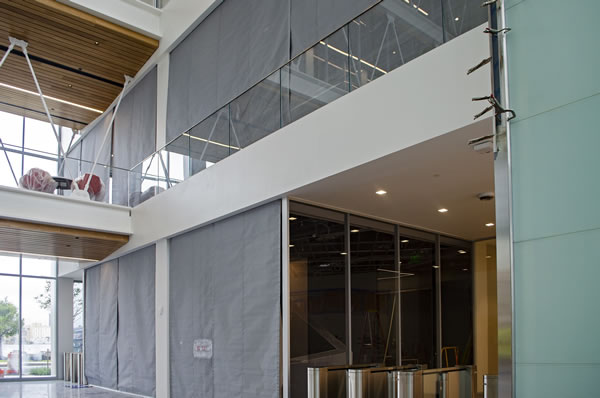Fire curtains are modern, popular fire protection solutions. They make buildings and the people within safer.
They act as barriers to the fire and control its spread and the resulting smoke and heat.
We explain the types and applications of fire curtains.
Understanding Fire Curtains
Fire curtains are flexible, fire-resistant barriers. They stay hidden within a headbox until deployed.
These curtains drop automatically between the guide channels on the fire alarm/smoke detector activating. This blocks off areas and makes rooms inside the building.
Creating separate areas helps:
- keep the fire inside
- stops smoke from spreading
- gives people time to safely leave the building
Types of Fire Curtains
Horizontal Fire Curtains: When these curtains are spread out horizontally, they separate floors or levels in a building. They keep smoke from getting to higher floors and are usually found in malls, atriums, and other large open spaces.
Vertical Fire Curtains: When put up vertically, these curtains can be used to block off openings like hallways, stairwells, and escalators. They are used to divide spaces and keep escape routes safe in both business and residential settings.
Perimeter Fire Curtains: The purpose of these curtains is to make a wall around a certain area. During a fire, they effectively separate that area from the rest of the building.
Insulated Fire Curtains: Adding more insulation to fire curtains makes them safer and more resistant to heat, so people can safely leave the building through them during an evacuation.
Applications of Fire Curtains
- Fire curtains are used to make places safer, like offices, stores, and hotels.
- They help protect people in residential settings like apartments and condos.
- They keep patients and staff safe in hospitals and nursing homes.
- Fire curtains are put up in schools and universities to keep students and staff safe.
- Fire curtains keep airports and train stations with a high risk of bigger casualties and damage, safe from fire.
- Warehouses and factories also use fire curtains to keep workers and property safe.
Benefits of Fire Curtains
Compartmentalization: Fire curtains divide a building into sections that stop fire and smoke from spreading and protect exits.
Flexibility in Design: Fire curtains, as opposed to regular fire-rated walls or doors, let architects make more open and flexible designs, making it possible to make bigger, clearer spaces.
Space-Saving: When they are folded up, fire curtains are small and unobtrusive, taking up very little space. For areas of restricted space, this works out well.
Cost-Effective: Fire curtains can be a cheaper way to protect against fire than other options, especially in large open spaces where other options may be too expensive or not work at all.
Looks: Fire curtains can be made to blend in with the inside of the building, so they don’t look too obvious when they are not in use.
Installation and Maintenance
Fire curtains must be installed and maintained correctly to work well and reliably during a fire.
Installation should only be done by trained professionals who follow the manufacturer’s instructions and the building codes in your area.
It’s also important to do regular checks, tests, and maintenance to find and fix any problems, like blockages, damage, etc.
If property owners and developers wish to install fire curtains for their projects, they should only talk to reputable companies to make sure they get solutions that fit their safety and design needs.
For more than 33 years, the A1S Group has been making and installing fire curtains, smoke curtains, fire shutters, and roller shutters. They are known for meeting strict safety standards and coming up with new, aesthetically pleasing fire safety solutions for a wide range of buildings, such as commercial, residential, and industrial ones.










